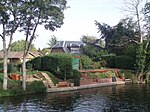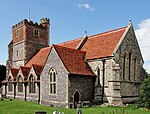Wraysbury No 1 Gravel Pit
Ramsar sites in EnglandSites of Special Scientific Interest in BerkshireSpecial Protection Areas in England

Wraysbury No 1 Gravel Pit is a 58.0-hectare (143-acre) biological Site of Special Scientific Interest in Wraysbury in Berkshire. It is part of South West London Waterbodies Ramsar site, and Special Protection Area. The lake has an area of 39.6 hectares (98 acres). The pit was excavated in the 1920s and 1930s with gravel being removed from the site. Over the years plants and wildlife have colonised the area and it is now mature.
Excerpt from the Wikipedia article Wraysbury No 1 Gravel Pit (License: CC BY-SA 3.0, Authors, Images).Wraysbury No 1 Gravel Pit
Waylands,
Geographical coordinates (GPS) Address Nearby Places Show on map
Geographical coordinates (GPS)
| Latitude | Longitude |
|---|---|
| N 51.463 ° | E -0.556 ° |
Address
Waylands
TW19 5DZ
England, United Kingdom
Open on Google Maps









